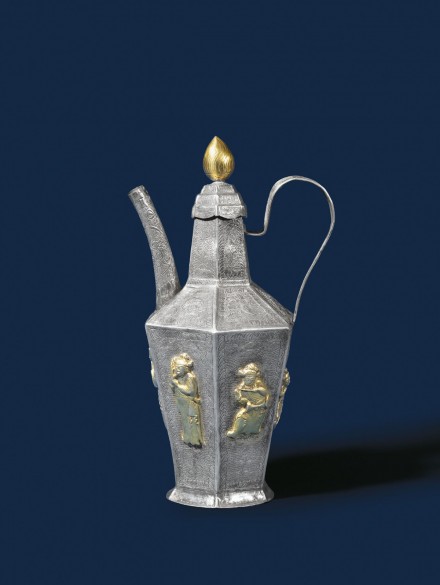J.J. Lally & Co., Oriental Art / New York City, New York
MenuPast Exhibition
Silver and Gold in Ancient China
March 16 – April 14, 2012

31.
A PARCEL-GILT SILVER ‘MUSICAL TROUPE’ EWER AND COVER
Liao – Northern Song Dynasty, A.D. 10th -11th Century
the hexagonal vessel of tall slender form decorated with six gilded figures in high relief including a dancer, a drummer and four different musicians playing Chinese instruments centering each of the six flat tapering sides, further decorated with a ring-matte punched ground embellished with incised foliate and cloud motifs above and below each figure, and with incised borders of overlapping petal motifs framing each panel, the sloping shoulders and tapering narrow neck also decorated with floral motifs on ring-punched grounds within petal-borders and the upright cylindrical spout and high arch-form handle similarly decorated, standing on a plain splayed hexagonal ring foot and with a small stepped cover with incised foliate decoration surmounted by a large gilded flame-shaped finial.
Height 10 inches (25.4 cm)
No other Chinese silver ewer of this form with figural decoration has been previously recorded, but a plain ewer of similar tall faceted shape is depicted in a painting on the wall of a tomb dated by epitaph to A.D. 1093, illustrated in Xuanhua Liao mu bihua (Tomb Murals of Liao Dynasty in Xuanhua), Beijing, 2001, no. 1, described in the catalogue as a scene of preparing tea.
An octagonal silver ewer and cover decorated with peony sprays in panels framed by incised borders of overlapping petal motifs very similar to the borders of the panels on the present ewer, and with a similar flame-shaped knop on the cover, discovered in 1978 in a Liao hoard at Balinyouqi in Ju’udmeng, Inner Mongolia is illustrated by Zhu Tianshu in Liao dai jinyinqi (Liao Dynasty Gold and Silver), Beijing, 1998, p. 137, fig. 32, with caption on pp. 94-95.
In the same monograph, op. cit. p. 42, Zhu relates that figural decoration is very rarely seen on silver vessels during the Liao dynasty and repoussé figures in high-relief did not appear until the mid-Liao period.
The Liao regarded themselves as successors to the Tang, and they showed a strong preference for Tang dynasty motifs and vessel shapes in their metalwork. ‘Silk Road’ musicians and dancers are a popular motif in Tang metalwork. Compare, for example, the famous Tang octagonal cups decorated with foreign entertainers discovered in the Hejiacun hoard excavated near Xi’an in 1970 and now in the Shaanxi History Museum, illustrated in Hua wu da Tang chun: Hejiacun yibao jingcui (Selected Treasures from Hejiacun Tang Hoard), Beijing, 2003, pp. 74-85, nos. 4-5. One of the same cups from Hejiacun was exhibited at the British Museum and illustrated in the catalogue by Michaelson, Gilded Dragons: Buried Treasures from China’s Golden Ages, London, 1999, p. 126, no. 90.
遼–北宋 鎏金伎樂紋八稜銀執壺 高 25.4 厘米
31.
A PARCEL-GILT SILVER ‘MUSICAL TROUPE’ EWER AND COVER
Liao – Northern Song Dynasty, A.D. 10th -11th Century
Height 10 inches (25.4 cm)